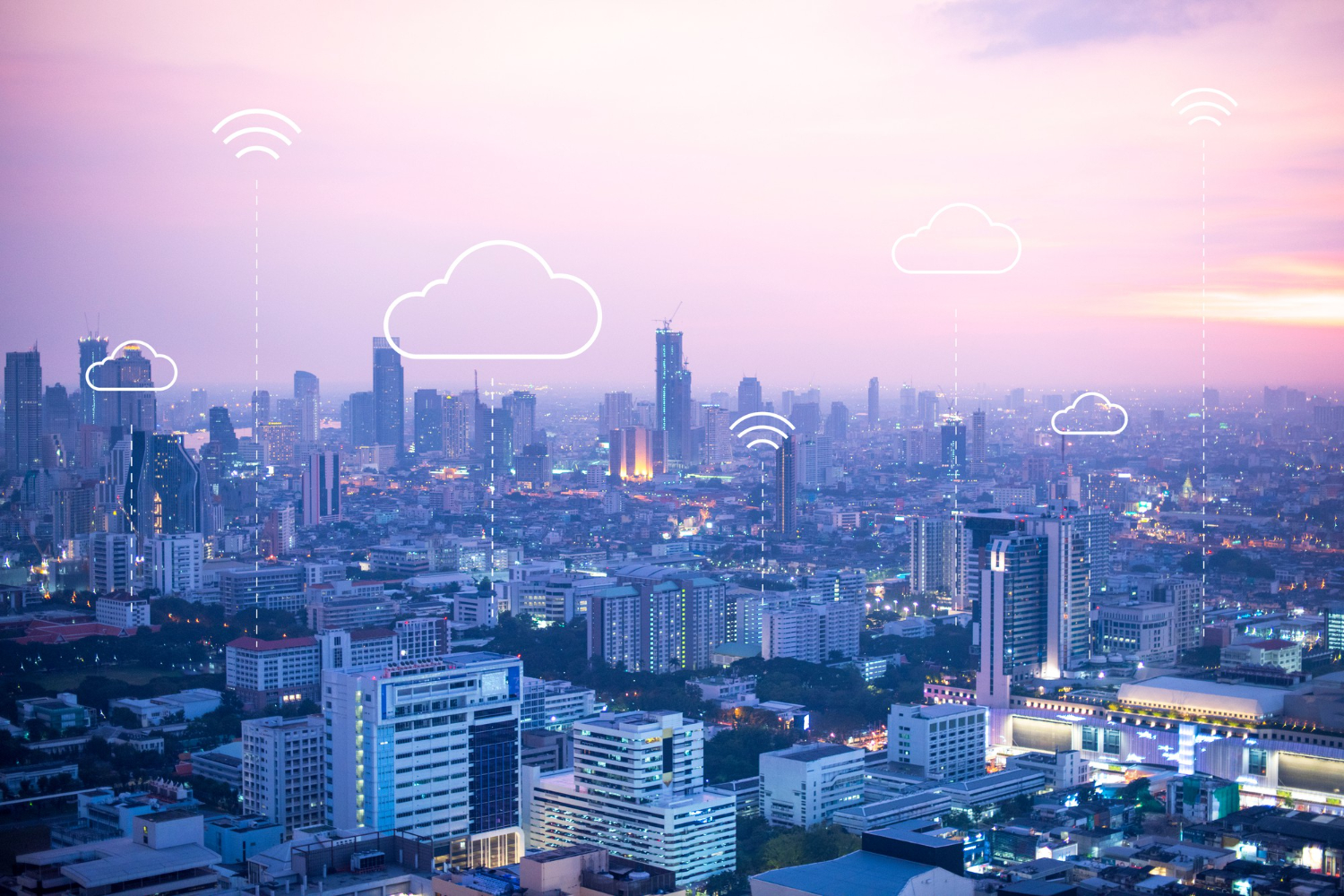
The IoT industry was in for quite a ride last year. 2021 saw growth and necessity for IoT devices across a wide range of industries. But it also saw a big slowdown in innovation and products getting to market due to chip shortages and supply chain issues.
Despite the rocky end of 2021, 2022 is looking a bit more promising for the industry. We spoke with industry leaders from all areas of IoT to get their take on where the IoT industry landed last year and where it’s headed in 2022.
Wearables
Consumer and personal healthcare took off last year. With a continued push on home health and fitness, wearable IoT technology hit its stride. And this industry is poised to grow and dominate again in 2022.
Consumers spent $81.5 billion (about $250 per person in the US) dollars on wearable technology that spans smartwatches, wristbands, smart clothing, and more. This is an 18% increase in spending from 2020.
”Given the sensor improvement trend seen over the last several years, sensors built into wearable devices will be increasingly capable of more accurate readings, driving market growth over the next 3-5 years.
Ranjit AtwalSr. Director Analyst, Gartner
Ranjit Atwal recently reported for Gartner, “the capability of embedded sensors is often a determining factor in the reliability and usefulness of a wearable product. Given the sensor improvement trend seen over the last several years, sensors built into wearable devices will be increasingly capable of more accurate readings, driving market growth over the next 3-5 years.”
Devices will continue to get more affordable too. The cost of IoT in general is becoming more affordable for many more companies, allowing prices for wearables to be accessible for many consumers.
“For the most part wearables have gotten cheaper.” said Andrew Kurtz, CEO of Kopis, a software development firm focusing on IoT software. “The cost of software is getting cheaper because of both investment at an infrastructure level to support IoT and IoT platforms that people are developing to create a general platform as a starting point. The cost of getting there, to where you have something to sell, has dropped significantly from where it was three years ago.”
The incentive for consumers to wear these devices is also continuing to grow. “There’s been a greater push by insurance companies and employers to promote healthier lifestyles and offer incentives for employees to use devices like a Fitbit wearable or connected treadmill to stay healthier and lower premiums. We only see this trend growing,” said Ralph Heredia, VP of Business Development at Zipit, whose platform removes the complexities of connecting devices to wireless carriers and enabling subscription services – making it easier to launch and monetize IoT solutions anywhere in the world.
IoT in Sports
Wearables will also continue expanded growth into sports, performance monitoring, and training.
“There is a lot of data collection coming out of sports. Teams are using sensors and wearables to collect data they can analyze and use for performance enhancement. This doesn’t have to be just in the professional space either. As an amateur cyclist, I use this technology to review my performance and adjust my training habits to become a better cyclist.” said Kurtz.
Garter predicts “advances in miniaturization have also been an influencing factor in the wearables market by enabling device makers to integrate sensors into wearables that are nearly invisible to the end user. By 2024, miniaturizing capabilities will advance to the point that 10% of all wearable technologies will become unobtrusive to the user.”
But IoT in sports and personal use won’t just be focused on activity and training. There will be a push next year on the mental health side. “We will see wearables break out of the athletics industry and measure things like brain health. New market sectors will innovate on the growing mental health push and stretch IoT devices into this area,” said Kevin Wentzel, COO and IoT leader at Kopis.
”We will see wearables break out of the athletics industry and measure things like brain health. New market sectors will innovate on the growing mental health push and stretch IoT devices into this area.
Kevin WentzelCOO and IoT Leader, Kopis

Healthcare – Remote Patient Monitoring
IoT devices have had a hard time breaking into the traditional healthcare market in the past due to policies and regulations around privacy and patient safety. However, one area that picked up traction last year was remote patient monitoring.
“There will be growth in patient monitoring this year,” said Kurtz. Remote patient monitoring looks like “if someone has a disease you want to monitor for and we have the ability to have sensors that can watch, alert, and provide feedback for the health provider.”
The COVID pandemic pushed many healthcare providers to rethink how they interacted with patients and open their practices to smart devices.
Companies like Smardii have been heavily honing this type of IoT over the past two years. Smardii’s flagship product is a puck that is used in combination with adult diapers to alert nurses on the health of their patients.
“It’s these types of innovations to healthcare that will change the landscape of care and we will see big increases in devices for this sector,” predicts Wentzel.
“The pandemic in particular has also dramatically changed society’s viewpoint and willingness to try things like telemedicine and connected devices for care,” said Heredia.
“Due to the ongoing severity of the pandemic, Healthcare will continue to be a main focus in the IoT market in 2022,” said Ron Vener, Business Development Manager for Connected Development.
”Due to the ongoing severity of the pandemic, Healthcare will continue to be a main focus in the IoT market in 2022.
Ron VenerBusiness Development Manager, Connected Development
Smart(er) Cities
“The idea of a smart city is still a bit ambiguous, but there are areas within the larger idea of a ‘smart city’ like transportation and utilities that are certainly getting smarter,” said Wentzel.
“Each sector, like waste collection and management, water systems, or traffic management will continue to improve in their own right. Think of them more as hubs, that, while not totally interconnected like one big hive mind, will each become more efficient and will become more equitable as local communities push for everyone to be covered and for transparency with how data is collected and used to better the neighborhoods and districts within the city,” added Heredia.
As cities continue to look for innovative ways to solve transportation issues, “we will see larger pushes for electric and autonomous transportation methods,” said Wentzel. “Autonomous seems like a far-off dream, and in all honesty, we are probably ten years out. But we will see transportation companies make more tech-first approaches in 2022.”
One example of this is Proterra, an electric bus manufacturer, implemented a tech first approach to their entire maintenance system. “Now technicians can walk on to a bus, turn on a computer and look at the motors, batteries, and all parts of the system to determine the problem without dismantling and running manual diagnostic tests” said Wentzel.
Tech-Driven Decisions
In order for cities to move in a tech-first direction, utilities will be an easy focus for many municipalities. “Cities will start defining more smart-capable utility devices, transportation departments will use cameras to determine if a car is sitting at a light to make better changes to traffic patterns. Cities can develop tech-first approaches to parking and power consumption can be controlled not just by schedule but monitored devices,” explained Wentzel.
“Deploying connected utility meters has changed the game for all types of utilities,” said Allen Proithis, CEO at Capstone Partners, a strategic advisory firm for clients interested in digital transformation. “We are seeing similar results across industries, connecting everything from industrial gas tanks to oxygen for hospitals. Even remote monitoring of consumables in bathrooms not only drives down costs, but provides a much better customer experience.”
“Government incentives like the infrastructure bill will fuel IoT investment and Digital Transformation, added Harald Remmert, CTO for Cellular Solutions at Digi.”Most importantly, easy to deploy, easy to monitor, and easy to use solutions, will be key to driving Digital transformation for Smart Cities, Smart Transit, Agriculture, and a high number of additionally popular verticals.”
”Easy to deploy, easy to monitor, and easy to use solutions, will be key to driving Digital transformation for Smart Cities, Smart Transit, Agriculture, and a high number of additionally popular verticals.
Harald RemmertCTO for Cellular Solutions, Digi
Ultimately, it’s about connectivity
Ultimately, it’s all about connectivity. Not necessarily a city where every single device is interconnected, but rather “greater access to mobility options for everyone), more sustainable buildings, less traffic congestion (maybe in the form of better traffic management or even better city planning to prioritize walking and cycling), and efficiency – like waste collection and maintenance teams only doing truck rolls when sensors have communicated that a pipe burst or trash bins are full,” explained Heredia.
“We think this will be a slow, mostly hidden transformation but in a few years we will all stop and realize a lot has actually changed and make for a better standard of living,” said Heredia.
One area pushing smart cities forward is the cost of connectivity. “Connecting many types of sensors in a city has traditionally been difficult due to wireless coverage and cost limitations. Cellular technologies such as NB-IOT and CAT-M have significantly dropped in price and have increased battery efficiency to become much more useful. Non-cellular LP-WAN technologies such as LoRa can also be a great fit for connecting the masses of devices that do not consume data and that need to last a long time. We must also acknowledge that Federal and State governments are funding certain types of IoT deployments at extraordinary levels. We can expect all levels of government to accelerate spending for providing cleaner water, air and an overall healthier environment,” said Proithis.
”We can expect all levels of government to accelerate spending for providing cleaner water, air and an overall healthier environment.
Allen ProithisCEO, Capstone Partners
But many cities have short term priorities that will make heavily investing in technology difficult.
“Smart Cities will continue to make some progress, but with an increase in natural disasters and crime, I think cities will decrease spending in this area. Repairing infrastructure like bridges, roads, water and sewer projects will suck a lot of cities’ management bandwidth. Advances in edge intelligence may accelerate smart cities down the road, but I don’t think there will be great advances in 2022,” said Vener.
Remote Work
“Working from home and remote connectivity including a backup connection source, accounted for a lot of growth in 2021, ” said Vener. “Realizing that there was improved productivity instead of decreased productivity, and that quality-of-life has improved as a result, has changed the way many businesses do business. Although I don’t think it will drive big growth in 2022, this technology has had a huge impact on business in 2021.
2021 also saw a great improvement in expanding wireless capabilities.
“Looking back on the past couple of years, connected devices were one of the key factors in enabling the huge wave of remote schooling and remote work during the height of the pandemic. Setting aside whether the remote experience is better or worse than traditional classrooms and offices, this would not have even been possible without the growth in connected devices and wireless coverage.
”Looking back on the past couple of years, connected devices were one of the key factors in enabling the huge wave of remote schooling and remote work during the height of the pandemic. Setting aside whether the remote experience is better or worse than traditional classrooms and offices, this would not have even been possible without the growth in connected devices and wireless coverage.
Ralph HerediaVP of Business Development, Zipit
At the same time that we now see businesses embracing hybrid or remote work models, we see technology shifting to capitalize on these trends with devices like laptop computers transitioning to cellular connectivity instead of just a Wi-Fi connection. This will enable people – be they employees or students, to access material and collaborate from even greater distances without being bound to locations like the home or traditional office,” said Heredia.
Now that most businesses have embraced some form of remote/hybrid work for the long-term, we will see more companies downsize physical office spaces and invest in technology to make what spaces they do intelligent. Whether it’s smarter security, temperature controlling capabilities, or booking conference rooms, smart offices will grow in 2022.
Remote Security
As workers migrated the home office, IT teams spent the year trying to fine tune their security practices. Remmert believes this will continue well into 2022, “enterprises will invest in better connectivity, collaboration, and security tools for their remote workers and for peace of mind regarding their overall network security.”
Chip Shortage & Supply Chain
“There is no doubt that chip shortages and supply chain issues significantly slowed down new products coming to market and innovation,” said Kurtz. “2022 will see a big push to bring manufacturing for sensors/chips back to the US.”
Remmert agrees, “Supply chain challenges will slow down IoT projects and there will be more companies that will look at nearshoring and in-country production to have more control over the supply chain. That being said, I still believe that the shipment gridlock will continue well into 2022.”
Zipit works with device manufacturers across a broad range of industries, and “this shortage is one of the few types of events that have a wide enough impact that it causes a challenge no matter what sector a company may be in. We don’t see this easing up in any meaningful way for at least another 6 months,” said Heredia. “That being said, the IoT industry in general is expected to see significant growth starting in the 3rd quarter of this year.”
”There is no doubt that chip shortages and supply chain issues significantly slowed down new products coming to market and innovation. 2022 will see a big push to bring manufacturing for sensors/chips back to the US.
Andrew KurtzCEO, Kopis
A Shift in Development Mindset
But hope is not all lost for companies looking to develop IoT projects in 2022. “If you are just now thinking about an IoT project you can do pre work. Invest in prototypes and storyboarding and get a small number of devices to test. If you are financially able to do this now and then wait to launch on a national scale – you will likely have a big market advantage,” said Wentzel.
A shift in development is starting that more companies will utilize throughout 2022 and beyond: “more companies have focused on contingency plans by designing in 2nd and 3rd backup suppliers, so they aren’t as impacted by a single source and create a domino effect that causes unique supply chain bottlenecks like we’ve been seeing. It took a singularly challenging global event like the pandemic to reveal this issue, and now companies across the world are adjusting accordingly,” said Heredia.
Vener has seen this impact clients first hand during the design process, “a lot of expensive changes are being made to projects. For example, customers are completing dual designs with different sourcing instead of standardizing on a single design. We had to tell a customer the lead time for a particular popular component was 80 weeks. Of course, that is untenable. Different design choices had to be made to either use multiple other components or figure out some type of redesign. I don’t see this getting much better in 2022.”
”If you are just now thinking about an IoT project you can do pre work. Invest in prototypes and storyboarding and get a small number of devices to test. If you are financially able to do this now and then wait to launch on a national scale – you will likely have a big market advantage.
Kevin WentzelCOO and IoT Leader, Kopis
Security
As more and more devices become connected, there is an ever greater threat about security and privacy for companies and end users.
“Security will be a top priority for CIOs in 2022. Driven by the distributed work-from-home workforce, remote assets (previously or newly unmanned), and an ever-increasing number of bad actors and botnets,” said Remmert.
When it comes specifically to IoT device security, it is a “key concern and building secure devices has become a major priority. Creators are willing to invest in security assessments and are designing in security features. This will continue to grow in 2022,” said Vener.
Glenn Johnson, CEO and Principal Engineer at the Vizius Group, has spent the last 20 years consulting businesses and IoT developers on security and has some advice for IoT vendors: “IoT vendors and software developers should think about the ways in which unsuspecting/untrained users might deploy these devices within their environments. The temptation for a vendor is to focus solely on making the device accomplish the mission, often at the expense of considering how that service might be abused. Security vulnerabilities in firmware, 3rd party hardware, and software components that make up the device are often exploited when these devices are installed on customer networks that also host sensitive information. Vendors should ensure that every device is subjected to a ‘penetration test’ prior to public release.”


